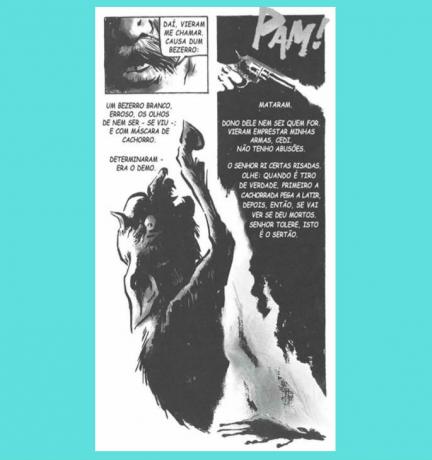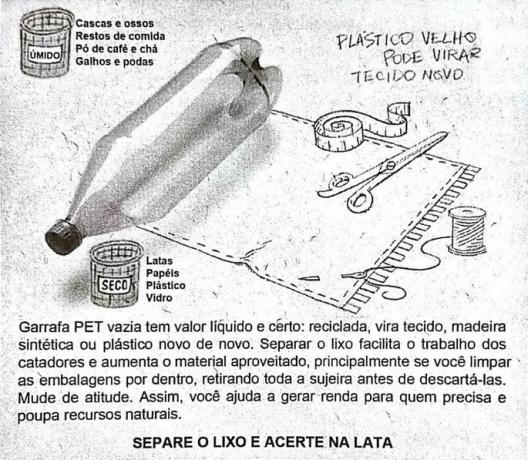This text was designed especially for you who are preparing for Enem. Do the exercises and check the answers: all, including the incorrect alternatives, are explained by a professor in the field.
Practicing is a great way to study. Good study!
1. (Enem/2018)

The internet provided the emergence of new social paradigms and boosted the modification of others already established in the spheres of communication and information. The main consequence criticized in the strip about this process is the
a) creation of memes.
b) expansion of the blogosphere.
c) supremacy of cybernetic ideas.
d) commercialization of views.
e) trivialization of electronic commerce.
Correct alternative: d) commercialization of views.
a) WRONG. Memes are not the target of criticism. The only reference made to them in the strip indicates the price difference between meme and "textão".
b) WRONG. Although the first frame of the cartoon makes a mention of blogs ("Weren't you an opposition blogger?"), it's not. related to the rise of the blogosphere, which is a virtual space that brings together blogs and bloggers as a network. Social.
c) WRONG. In the strip, there is no reference to cybernetics.
d) CORRECT. The strip criticizes the opportunistic posture of some professionals. The first box, for example, shows how ethics can take a back seat due to personal advantage. (The "left-wing blogger" ceases to be because of a professional opportunity.)
e) WRONG. At first glance, the content may be related to e-commerce, because the strip mentions terms related to billing ("Meme eu charge x") and at price ("Did you see the price of opinion on the Internet?"), however, the title points to a theme that goes beyond electronic commerce ("Ideology and Internet").
2. (Enem/2018)
“Acuenda o Pajubá”: get to know the “secret dialect” used by gays and transvestites
Originating in Yoruba, the language was adopted by transvestites and won the community
“Nhaí, amapô! Don't do the loka and pay my acué, don't worry if I don't, I'll pull your picumã!" Did you understand the words in that sentence? If so, it's because you know something about pajubá, the “secret dialect” of gays and transvestites.
Adept at using expressions, even in the most formal environments, one lawyer says: “Of course I'm not going to talk during a hearing or a meeting, but at the firm, with my co-workers, I talk about 'acué' all the time", jokes. “We have to be careful about saying other words because today people already understand, right? It's on the internet, there's even a dictionary...”, he comments.
The dictionary he refers to is the Aurelia, the sharp-tongued dictionary, released in 2006 and written by journalist Angelo Vip and Fred Libi. In the work, there are more than 1,300 entries revealing the meaning of the words of the pajubá.
It is not known for sure when this language appeared, but it is known that there is clearly a relationship between pajubá and African culture, in a seam that began in colonial Brazil.
Available at: www.midiamax.com.br. Accessed on: 4 Apr. 2017 (adapted).
From the user's perspective, pajubá gains the status of a dialect, characterizing itself as an element of linguistic heritage, especially by
a) have more than a thousand known words.
b) have words other than a secret language.
c) be consolidated by formal registration objects.
d) be used by lawyers in formal situations.
e) be common in conversations in the workplace.
Correct alternative: c) be consolidated by formal registration objects.
a) WRONG. It is not the fact of having a certain amount of known words that makes pajubá an element of linguistic heritage, but the initiative promoted by the authors of the dictionary "Aurelia, the sharp tongue dictionary".
b) WRONG. It is not the fact that it has different words from a secret language that makes pajubá an element of linguistic heritage. Its consolidation, in these terms, is given by the initiative of the authors of the dictionary "Aurelia, the sharp tongue dictionary".
c) CORRECT. The fact that there is a dictionary for pajubá, the "Aurelia, the dictionary of sharp tongue", promotes its consolidation, so that it is not lost over time.
d) WRONG. The use by lawyers was just one example given in the text. Pajubá is certainly used by speakers from several different professional and non-professional communities.
e) WRONG. The fact that it is currently used in the work environment does not promote the character of a linguistic heritage to the pajubá.
3. (Enem/2018)
My mother once beat me with a gnarled rope that painted my back with bloody stains. Crushed, turning my head with difficulty, I could make out large red stripes on the ribs. They laid me down, wrapped me in cloths dampened with salt water – and there was an argument in the family. My grandmother, who was visiting us, condemned her daughter's behavior and she was distressed. Irritated, she had hurt me for nothing, without meaning to. I didn't hate my mother: the culprit was the knot.
BRANCHES, G. Childhood. Rio de Janeiro. Record, 1998.
In a narrative text, the sequence of events contributes to thematic progression. In the fragment, this process is indicated by the
a) alternation of people in the discourse that determine the narrative focus.
b) use of verbal forms that mark different narrative times.
c) indeterminacy of the subjects of actions that characterize the narrated events.
d) juxtaposition of sentences that semantically relate the narrated events.
e) recurrence of adverbial expressions that temporally organize the narrative.
Correct alternative: b) use of verbal forms that mark different narrative times.
a) WRONG. The alternation of people does not contribute to the progression of the text.
b) CORRECT. "Whipped me, turning, distinguished, wounded me" are examples of verbal forms that appear in the text and that promote its progression.
c) WRONG. Although in the prayers "They laid me down, they rolled me up..." the subjects are indeterminate, it is not this characteristic that promotes the progression of the text.
d) WRONG. The semantic relationship is important for a text to develop naturally. This means that a text, to be coherent, cannot start by informing something and change the central theme without the reader being informed about this change. Nevertheless, it is the verbal forms (alternative b) that most contribute to the thematic progression of this text.
e) WRONG. Adverbial phrases, or adverbial expressions - as the alternative mentions - are not recurrent in the text. The only occurrence is at the beginning of the text ("Once").
You may also be interested in:
- Narration: what is it, types, elements and examples
- Narrative Text: what is it, structure, elements, types and examples
4. (Enem/2018)

The image is part of a comic book adaptation of the work Grande sertão: veredas, by Guimarães Rosa. In graphical representation, the interrelationship of different languages is characterized by
a) break with the linearity of the actions of the literary narrative.
b) reliably illustrate representative passages of history.
c) articulate the tension of the novel with the disproportionality of forms.
d) enhance the drama of the episode with visual arts resources.
e) deconstruct the layout of the literary text through the imbalance of composition.
Correct alternative: d) enhance the drama of the episode with visual arts resources.
a) WRONG. Not all narratives are linear. As for the plot, the narrative text can be linear, non-linear, psychological or chronological.
b) WRONG. Although the image is an explicit intertextuality, because it is an adaptation of Grande sertão: veredas, it is not reliability that characterizes this resource, after all there is implicit intertextuality.
c) WRONG. Intertextuality is not characterized by articulating aspects, such as tension in the text. Intertextuality is the simple relationship between texts, which can happen in various ways - written, visual, among others.
d) CORRECT. The text in question presents mixed language, that is, it uses verbal (words) and non-verbal (visual signs) language. By gaining a comic book version, the emblematic work of Guimarães Rosa manages to convey in a more intense way the drama dealt with in this novel.
e) WRONG. Intertextuality does not aim to deconstruct a text, but rather to establish a relationship with one or more texts.
5. (Enem/2018)
More big than bang
Last week, the world scientific community received official confirmation of a discovery that was being talked about with great anticipation a few months ago. Researchers at the Harvard-Smithsonian Center for Astrophysics have revealed they have obtained the strongest evidence to date that the universe we live in actually started with the Big Bang, but this one it was not an explosion, but a sudden expansion of infinite matter and energy concentrated in a microscopic point that, without many semantic options, scientists call a "singularity". This cosmic seed remained in a latent state and, without a definitive explanation yet, it began to swell rapidly [...]. Within the blink of an eye, for example, it would therefore be possible for more than 10 trillion Big Bangs to occur.
ALLEGRETTI, F. Look, March 26. 2014 (adapted).
In the title proposed for this scientific popularization text, by dissociating the elements of the expression Big Bang, the author reveals the intention of
a) highlight the recent discovery that proves the explosion of matter and energy.
b) summarize the results of research that provided evidence for the Big Bang theory.
c) synthesize the idea that the theory of expansion of matter and energy replaces the theory of explosion.
d) highlight the experience that confirms previous research on the theory of matter and energy.
e) condense the conclusion that the explosion of matter and energy takes place at a microscopic point.
Correct alternative: c) synthesize the idea that the theory of expansion of matter and energy replaces the theory of explosion.
a) WRONG. The deconstruction in the name of the theory in the title of the text is intended to show something different than what people believed until now, namely, that the Big Bang was not an explosion.
b) WRONG. The fact that the words "big" and "bang" have been separated indicates that the text contains new information, not a summary of evidence for that theory.
c) CORRECT. The title "bigger" is linked to the idea of greatness, of expansion, which is what the study reveals, that is, that the Big Bang would have been "a sudden expansion of infinite matter and energy concentrated in a microscopic point", and not an explosion, as has been believed for so long. time.
d) WRONG. The intent of the title is quite clear with regard to the intention to inform something specifically about the Big Bang, and not any theory of matter and energy.
e) WRONG. The studies reveal precisely that the Big Bang would not have been an explosion, but an expansion, contrary to what was previously believed.
6. (Enem/2018)
Only a few dry tufts of cobbled grass grow in the silent lowland that is out of sight. Only one tree, large and sagging but with very few leaves, opens up in shreds of shade. The only being nearby, the woman is thin, bony, her face streaked with the wind. You can't see her hair, covered with a desiccated cloth. But his eyes, his mouth, his skin – everything is suffocatingly barren. She is standing. Next to it is a stone. The sun explodes.
She was standing at the end of the world. As if she were walking down that slope, letting go of her notions of herself. She has no portraits in her memory. Dispossessed and dispossessed, she does not descend into self-accusations and remorse. She lives.
Your shadow only keeps you company. Her shadow, which spills out in thick lines on the sand, sweetens the skeletal clarity as a gesture. The emptied woman mutes, bleeds, crystallizes, mineralizes. She is already almost stone like the stone beside her. But her shadowy streaks walk and, becoming longer and thinner, stretch out to the rags of shadow on the tree's bone, with which they entwine.
FRÓES, L. Dizziness: collected work. Rio de Janeiro: Rocco, 1998.
In the presentation of the landscape and the character, the narrator establishes a correlation of meanings in which these elements intertwine. In this process, the human condition configures itself
a) amalgamated by the common process of desertification and loneliness.
b) strengthened by extensive adversity to land and living beings.
c) resized by light intensity and local exuberance.
d) immersed in an existential drama of identity and origin.
e) immobilized by scarcity and oppression of the environment.
Correct alternative: a) amalgamated by the common process of desertification and loneliness.
a) CORRECT. The final part of the text describes this process well, in which landscape and character seem to blend together as something unique: "It is already almost stone like the stone beside it. But the traces of their shadow walk and, becoming longer and thinner, stretch out to the rags of shadow on the tree's bone, with which they entwine."
b) WRONG. The text does not show a strong woman, but in a condition conforming to the situation: "Dispossessed and deprived, she does not descend into self-accusations and remorse. She lives. ".
c) WRONG. The landscape is simple, with no evidence of any local exuberance: "Only a few dry tufts of cobbled grass grow in the silent lowland that is out of sight."
d) WRONG. The text does not contain any questioning that evidences existential drama on the part of the character. On the contrary, the woman assumes a resigned posture, as already mentioned: "Dispossessed and dispossessed, she does not descend into self-accusations and remorse."
e) WRONG. The text does reveal the scarcity of the environment, a condition that oppresses women. Despite this, the character goes through a process of fusion with the landscape, as shown in alternative a).
7. (Enem/2018)

In this campaign, the main strategy to convince the reader to recycle garbage is the use of non-verbal language as an argument for
a) reuse of material.
b) ease of garbage separation.
c) improvement of the scavenger's condition.
d) preservation of natural resources.
e) income generation for the worker.
Correct alternative: a) reuse of material.
a) CORRECT. Needle, scissors, thread and measuring tape next to the PET bottle give an indication of how plastic can become fabric and that is what the campaign intends to convince readers of.
b) WRONG. Despite containing two baskets - dry and wet - the highlight of the image is the PET bottle with objects used in sewing, that is, the reuse, not the separation of waste.
c) WRONG. The non-verbal language makes no references to garbage collectors, which are only mentioned in the written content ("Separating garbage makes the collectors' work easier...").
d) WRONG. The image above makes no mention of natural resources. As for verbal language, the text ends with "This way, you help generate income for those in need and save natural resources."
E) WRONG. The campaign, as far as non-verbal language is concerned, does not promote any relationship with income generation.
Don't stop there. There are more texts very useful for you:
- Enem questions commented by experts
- Simulated Enem (questions commented by experts)
- Enem: everything you need to know
- Enem study plan: tips and apps for you to get organized
- How to study for Enem: valuable tips to do well!
- Enem geography: subjects that fall the most


